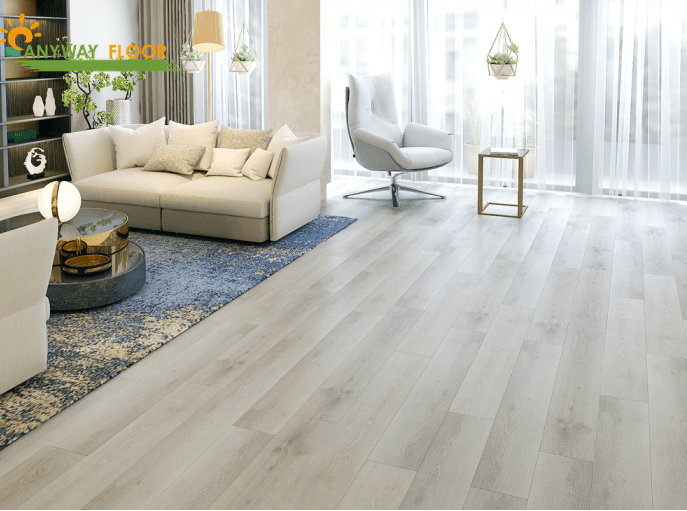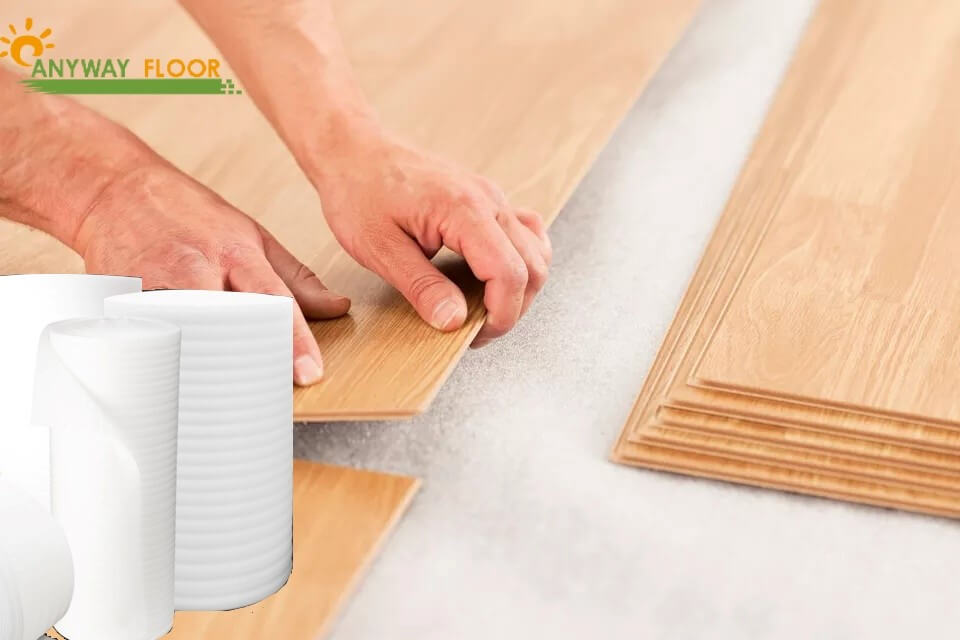
The Ultimate Guide to SPC Flooring: Construction, Benefits, Maintenance and Installation.
Stone Plastic Composite (SPC) flooring is an upgrade version of LVT. It is also called Rigid Vinyl Plank or RVP. It consists of a key ingredient of calcium carbonate on the inner core which is limestone. It is very dense and solid because of the minimal air component which makes the product very rigid. This rigidity is essential because you can mill in your joint structures. You can click and install SPC flooring similarly to a laminate floor. It can bridge slight undulations in the substrate so you don’t behave to be as pedantic as you would with vinyl and traditional vinyl products.


SPC flooring is budget friendly and because it’s so dense the sound and the feel of the product can be a little bit hard on the ear and on the foot. Generally, all products of SPC come with a built-in underlay. There are various options available from cork, IXPE, or various rubber components, however, it is a lovely product. In cleaning and maintenance, all of the mentioned products are much the same. The SPC flooring is rigid which is why have much more resistant to heat and temperature, therefore, is very suitable for the area with high temperature. It can be installed easily and quickly, and you do not have to worry about the sun bearing down on the product. In this article, we will provide an ultimate guide to SPC flooring, covering its construction, benefits, installation, and maintenance.
The Construction of our SPC flooring:
There are multiple layers in the SPC flooring discussed below:
1. UV Coating layer:
This is a layer on the surface of the flooring. It is cured on the surface of the flooring by UV light. The UV layer can have a glossy or matt finish. It protects the surface from stains, resists UV rays and ensures that the floor does not fade after a long period of sunlight exposure.
2.Wear Layer:
It is the part between the UV layer and the decorative layer. The wear layer helps to protect the plank from stain and scratch resistance. The thickness of the wear layer is usually proportional to the manufacturer’s warranty, the thicker the layer, the longer the warranty period.
3.Decorative Color Film:
The high-quality finish layer gives the floor a realistic wood or stone grain effect, with a more designed look in terms of colour, pattern and texture.
4.SPC core:
The thickest and hardest layer of the entire SPC flooring. It is the core of the whole floor, made of stone powder and PVC resin powder fused and pressed together. It helps to create a dimensionally stable and waterproof core.
5. Attached underlayment:
SPC floor coverings are made of EVA or IXPE with thicknesses of 1.0mm – 1.5mm. These backings are used for sound reduction, heat retention and overall comfort.With thicker underlayment’s comes more sound reduction, With thicker underlayment’s comes more sound reduction, and impact absorption (overall comfort).


Benefits of SPC Flooring
1. Durability
One of the main benefits of SPC flooring is its exceptional durability. SPC flooring is made of a mixture of natural limestone powder, polyvinyl chloride (PVC), and stabilizers. The combination of these materials creates a flooring material that is incredibly strong and can withstand heavy traffic without showing signs of wear and tear. Unlike traditional vinyl flooring, which can be easily scratched or dented, SPC flooring is resistant to scratches and dents.
2. Waterproof
One of the primary benefits of SPC (Stone Plastic Composite) flooring is its waterproof nature. SPC flooring is made up of a core of stone plastic composite material, which is highly resistant to water and moisture. This means that SPC flooring is not only suitable for use in high-traffic areas, but it is also ideal for use in areas that are prone to moisture, such as kitchens, bathrooms, and laundry rooms.
SPC flooring is designed with a unique locking system that creates a tight, seamless seal between the planks, preventing water from seeping through the gaps. The surface of SPC flooring is also coated with a waterproof layer, which provides an extra layer of protection against water damage.
Another advantage of SPC flooring is that it is resistant to mold and mildew growth. Because SPC flooring is made of materials that do not absorb water, it is less likely to develop mold or mildew, even in areas with high levels of moisture.SPC flooring is an excellent choice for those looking for a waterproof flooring option that can withstand the wear and tear of daily life. Its waterproof and mold-resistant properties make it ideal for use in high-moisture areas, while its durability and easy maintenance make it a popular choice for both residential and commercial applications.
3. Easy Installation
SPC flooring is relatively easy to install compared to other types of flooring materials. SPC flooring comes in a range of different styles and colors, and can be installed over existing flooring materials, such as concrete or tile. The flooring is also designed to click together, making it easy to install without the need for any special tools or adhesives. This means that homeowners can save money on installation costs by installing the flooring themselves.
4. Low Maintenance
One of the primary benefits of SPC (Stone Plastic Composite) flooring is its low maintenance requirements. Unlike other flooring options, SPC does not require any special cleaning products or treatments. It can be cleaned with just a damp mop or cloth. SPC flooring is highly resistant to scratches, stains, and water damage, making it an ideal choice for high-traffic areas such as kitchens, bathrooms, and entryways. The surface of SPC flooring is also resistant to fading, so it can maintain its original appearance for years to come. Another advantage of SPC flooring is that it is easy to maintain. Regular sweeping or vacuuming can help to remove dirt and debris from the surface, and spills can be wiped up quickly and easily to prevent staining.
SPC flooring also has a protective layer that helps to prevent dirt and grime from getting trapped in the surface. This layer helps to keep the flooring looking clean and new, even after years of use.
Overall, SPC flooring is an excellent choice for those looking for a low maintenance flooring option that can withstand the wear and tear of daily life. Its durability and ease of maintenance make it a popular choice for both residential and commercial applications.
5. Cost-Effective:
SPC flooring is a cost-effective option compared to other types of flooring, such as hardwood, tile, or carpet. It is also more affordable than other types of vinyl flooring, such as luxury vinyl tile (LVT) or engineered vinyl plank (EVP). Additionally, its easy installation process means that you can save money by installing it yourself, rather than paying for professional installation.
6. Aesthetically Pleasing:
SPC flooring comes in a wide range of styles, colors, and patterns, making it easy to find the perfect match for your home or business. It can mimic the look of hardwood, tile, or stone, giving you the aesthetic appeal of those materials without the high cost and maintenance.
7. Sound:
with the dense core, SPC flooring tends to have a quieter sound. You will not hear a hollow sound when you walk on it.
8. Comfort:
The SPC floor feel cushioned and sturdy under foot as compared to a traditional vinyl because of the thickness and dense core. SPC have attached underlayment that adds comfort to the softness under foot.
Installation of SPC Flooring
Installation of SPC (Stone Plastic Composite) flooring is a straightforward process that can be done by anyone with basic DIY skills. The interlocking planks that make up SPC flooring can be clicked together and installed without the use of nails or glue. Below we will go over the installation process of SPC flooring in detail.
Preparation
Before installing SPC flooring, you need to prepare the room. Remove any existing flooring and ensure that the subfloor is clean and level. If there are any uneven areas, you may need to use a self-leveling compound to create a smooth surface.


Acclimation
SPC flooring should be acclimated to the room where it will be installed for at least 48 hours before installation. This allows the flooring to adjust to the temperature and humidity of the room, which can prevent any issues with expansion or contraction later on.
SPC flooring is a popular choice for homeowners and business owners alike because of its durability, versatility, and easy installation process. Unlike traditional flooring options, SPC flooring can be installed without the use of nails or glue, making it a great DIY project. Below we explains the installation process of SPC flooring in detail.
Before starting the installation process, it is important to prepare the room properly. This involves removing any existing flooring and ensuring that the subfloor is clean and level. If there are any uneven areas, you may need to use a self-leveling compound to create a smooth surface. Next, you will need to acclimate the SPC flooring planks to the room where they will be installed. This is important to prevent any issues with expansion or contraction later on. The planks should be left in the room for at least 48 hours before installation.
Once the planks have acclimated, it's time to start the installation process. Here are the steps to follow:
1. Begin by laying the first plank in the corner of the room, with the tongue facing out. Make sure that the plank is perpendicular to the longest wall in the room.
2. Click the second plank into the first plank, making sure that the edges are aligned. Use a tapping block and a mallet to ensure a tight fit.
3. Continue laying the planks in this way, clicking each one into the previous one until you reach the end of the row. Cut the last plank to fit if necessary, leaving a gap of around ¼ inch between the last plank and the wall. This gap is important to allow for expansion and contraction of the flooring.
4. Start the next row by using the cut plank from the previous row as the first plank in the new row. This helps to stagger the seams and create a more natural-looking floor. Again, make sure that the edges are aligned and use a tapping block and a mallet to ensure a tight fit.
5. Continue laying the planks in this way, clicking each one into the previous one until you reach the end of the row. Cut the last plank to fit if necessary.
6. Repeat steps 4 and 5 until you have covered the entire floor.
7. If you have any obstacles, such as pipes or vents, use a jigsaw or a hole saw to cut the planks to fit around them.
Once you have laid all of the planks, you can install any trim or molding around the edges of the room to give it a finished look. If you have any gaps between the flooring and the walls, you can use a color-matched caulk to fill them in. The installation process of SPC flooring is relatively straightforward and can be done by anyone with basic DIY skills. The interlocking planks make it easy to install without the use of nails or glue, and the flooring can be cut to fit around obstacles using a jigsaw or hole saw. The key is to take your time and ensure that the planks are aligned properly to create a smooth, seamless surface.
In sum, SPC flooring is a great choice for those looking for a durable, versatile, and easy-to-install flooring option. With proper preparation and acclimation, the installation process of SPC flooring can be completed in just a few simple steps, and the result is a beautiful, low-maintenance floor that can withstand the wear and tear of daily life.
English
Русский
العربية
Français
Español
Português
Deutsch
italiano
日本語
한국어
Nederlands
Tiếng Việt
ไทย
Polski
Türkçe
አማርኛ
Bahasa Melayu
ဗမာစာ
Filipino
Bahasa Indonesia
magyar
Română
Čeština
Српски
हिन्दी
فارسی
Kiswahili
Slovenčina
Slovenščina
Norsk
Svenska
українська
Ελληνικά
Suomi
Հայերեն
עברית
Dansk
اردو
বাংলা
Hrvatski
Eesti keel
नेपाली
latviešu
Euskara
Български
Català
Hausa
íslenska
Lietuvių
Malti
isiZulu
















